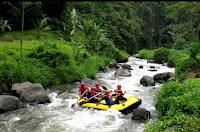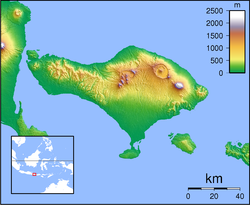ecak Dance
black_mimi99 Says:
when sun almost down, we can
see the kecak dance show... The Kecak Dance while look this sunset is
every night performed and very popular.About 50 male choruses like "Cak
Cak Cak..." are rhythmical. In addition, demon king Rahwana or white
monkey Hanoman are approach the...
austarman Says:
This temple is one of the
oldest and most sacred temples in Bali with an absolutely fantastic view
out over the Indian ocean from the top of some huge cliffs.It's a great
cultural experiance to walk through this old temple with a local person
who can explain the layout and...
balisunshine Says:
If you’re stationed at the
Bukitwhile visiting Bali,and desire a luxurious pampering,but don’t want
to drive down to the Bali downtown,then opt a spa session at the
Calyx.Prices are not cheap here,but if you have the cash or that special
occasion,then this spa may be a...
Ubud, a town in central
Bali, is far removed from the drunken bikini scene in
Kuta,
and is regarded as the cultural centre of Bali. It is famous as an arts
and crafts hub, and much of the town and nearby villages seems to
consist of artists' workshops and galleries. There are some remarkable
architectural and other sights to be found, and a general feeling of
well being to be enjoyed, all thanks to the spirit, surroundings, and
climate of the place.
Understand
While Ubud seems to outsiders like one small town, it is in fact fourteen villages, each run by its own
banjar
(village committee). Ubud has grown rapidly, and some central parts are
creaking under the strain of coping with the number of visitors. That
said, most development is sympathetic to the zeitgeist, if not designed
specifically in the local style. Growth continues apace, but there are
still terraced rice fields along the rivers, and away from the town
centre, regular, quiet village life carries on relatively undisturbed.
History
In many ways, the history of the Ubud
area (not so much the modern day town) is the very history of Bali itself.
Ubud has a known history back to the eighth century, when the
Javanese Hindu priest Rsi Marhandya came to Bali from Java, and
meditated at the confluence of the two Wos rivers at Campuan, just west
of the modern day town centre. A shrine was established and later
expanded by Nirartha, the Javanese priest who is regarded as the founder
of Bali's religious practices and rituals as we know them today. At
this time the area was a centre of natural medicine and healing, and
that is how the name Ubud originated:
Ubad is ancient Balinese for medicine.
Further temples and monasteries were established over the next
400 hundred years or so. The temple complex at Gunung Kawi, and the cave
temples at Goa Gajah (just east and northeast of Ubud), are
architectural remains from this period. Many of the dances, drama and
rituals still practised in Ubud today, originated at this time. King
Airlangga ruled all of Java and Bali in this era, and his seat of
government was located in what is now the village of Batuan, just
southeast of Ubud.
The Javanese Majapahit kingdom conquered Bali in 1343, and the
key final victory was against the Pejeng Dynasty centred at Bedulu, just
to the east of Ubud. A great flowering of Balinese culture followed,
and the ancestry of Ubud's current day aristocratic families can be
traced back to this period. In the sixteenth Century, there was a total
transplantation of the Majapahit Kingdom to Bali as the Islamisation of
Java forced them eastwards. Power flip-flopped between various dynasties
and feudal lords, but the Ubud area remained a very important cog in
the various regencies which ruled the island.

Goa Gajah originates from the 9th century
In 1900, Ubud became a Dutch protectorate at its own request, and the
colonialists interfered little, allowing the traditional arts and
culture of the area to remain relatively unchanged. The modern era of
Ubud perhaps began in the 1930s, when foreign artists were encouraged by
the royal family to take up presence in the town. From their Ubud base,
the likes of Walter Spies and Rudolph Bonnet were instrumental in
promoting an understanding of Balinese art and culture worldwide. From
the 1960s onwards, travellers started to arrive in earnest, mostly
intrepid types as the infrastructure was still very limited indeed.
Since then, Ubud has developed rapildy into a high profile, top class
international destination, whilst still maintaining its integrity as the
centre of Balinese art and culture.
Orientation
Orienting yourself in Ubud is fairly straightforward. The town
sprawls for several kilometres in all directions, with all of the small
villages within a five km radius of the central market being loosely
referred to as "Ubud". If you choose a reasonably central place to stay,
it is easy enough to get around on foot.
Central Ubud has three main streets: Jl Raya Ubud, Jl Monkey
Forest and Jl Hanoman. At the intersection of Jl Raya and Jl Monkey
Forest are Ubud Market, Ubud Palace, and the main
bemo stop — unsurprisingly, there's also a near-permanent traffic jam here.
Jl Monkey Forest, which runs south through town to the Monkey
Forest, is a built-up area, and home to a wide array of accommodation,
art galleries, and cafes, as well a number of local services such as
schools, a sports field, pharmacies, and travel agents. Jl Hanoman,
which runs parallel to Jl Monkey Forest just to the east, is a bit
quieter and makes for more pleasant walking.
To the immediate west and northwest are the villages of
Campuan (
Tjampuhan,
Campuhan) and
Kedewatan, home to some of the most upmarket hotels in the whole of Asia, with views over valleys sculpted by the Ayung and Wos rivers.
Directly to the south, past the Monkey Forest and still within a twenty minute walk of the central market, is
Padang Tegal which then runs into the southern villages of
Nyuh Kuning and
Pengosekan, about three km from central Ubud. Directly to the east is the village of
Peliatan, and then
Teges and
Bedulu, home of the ninth century
Goa Gajah (Elephant Cave).






















